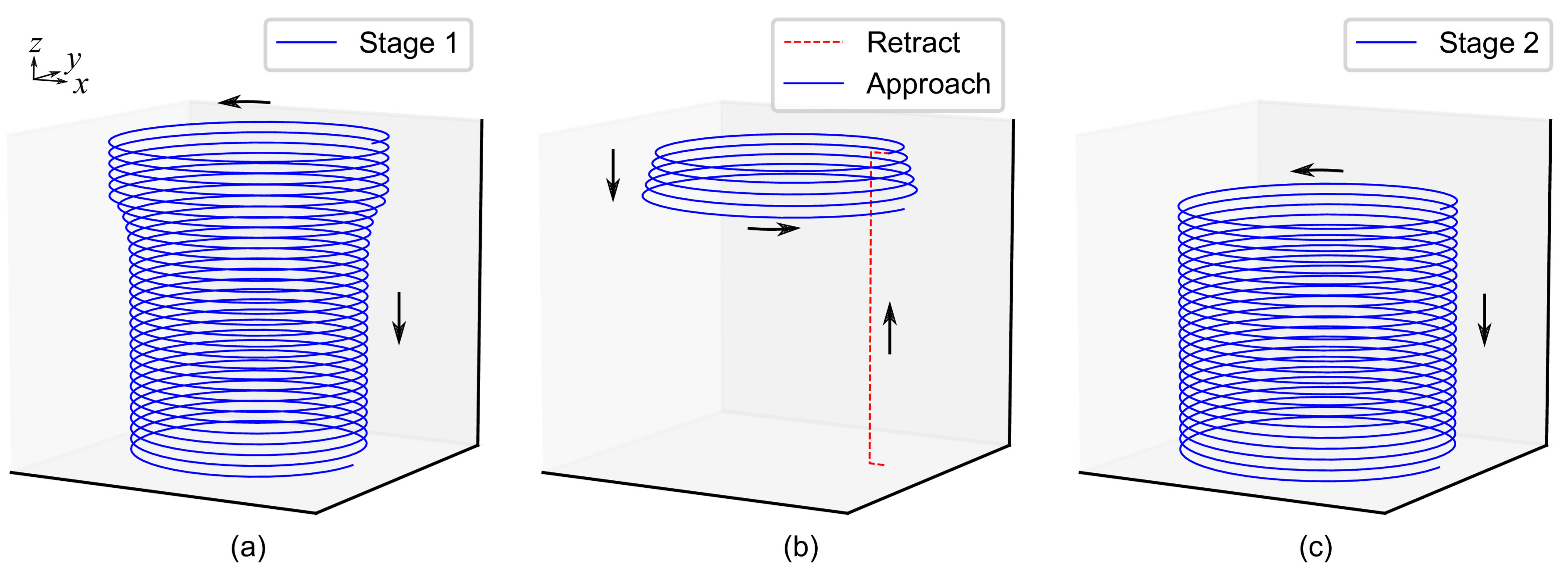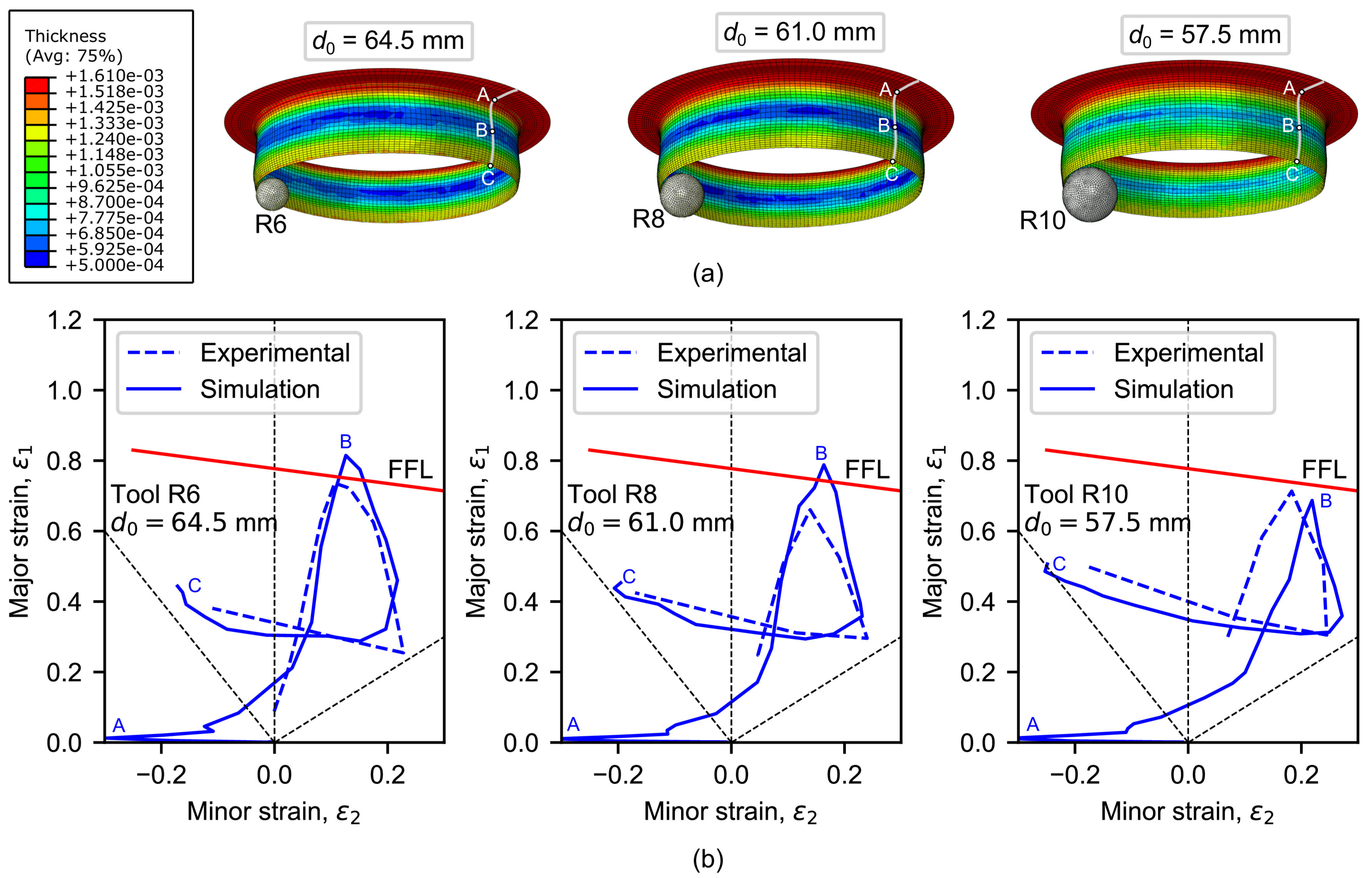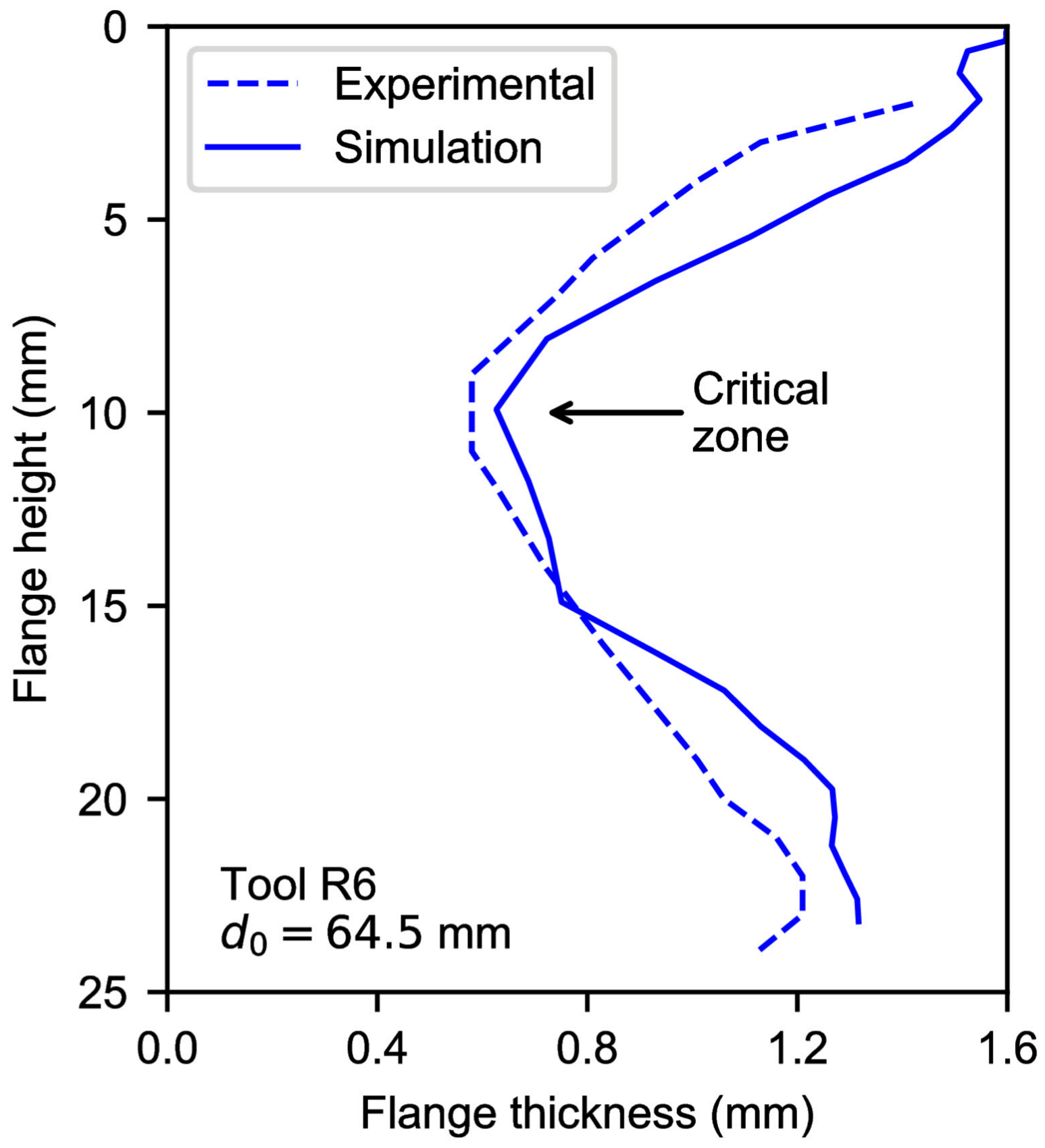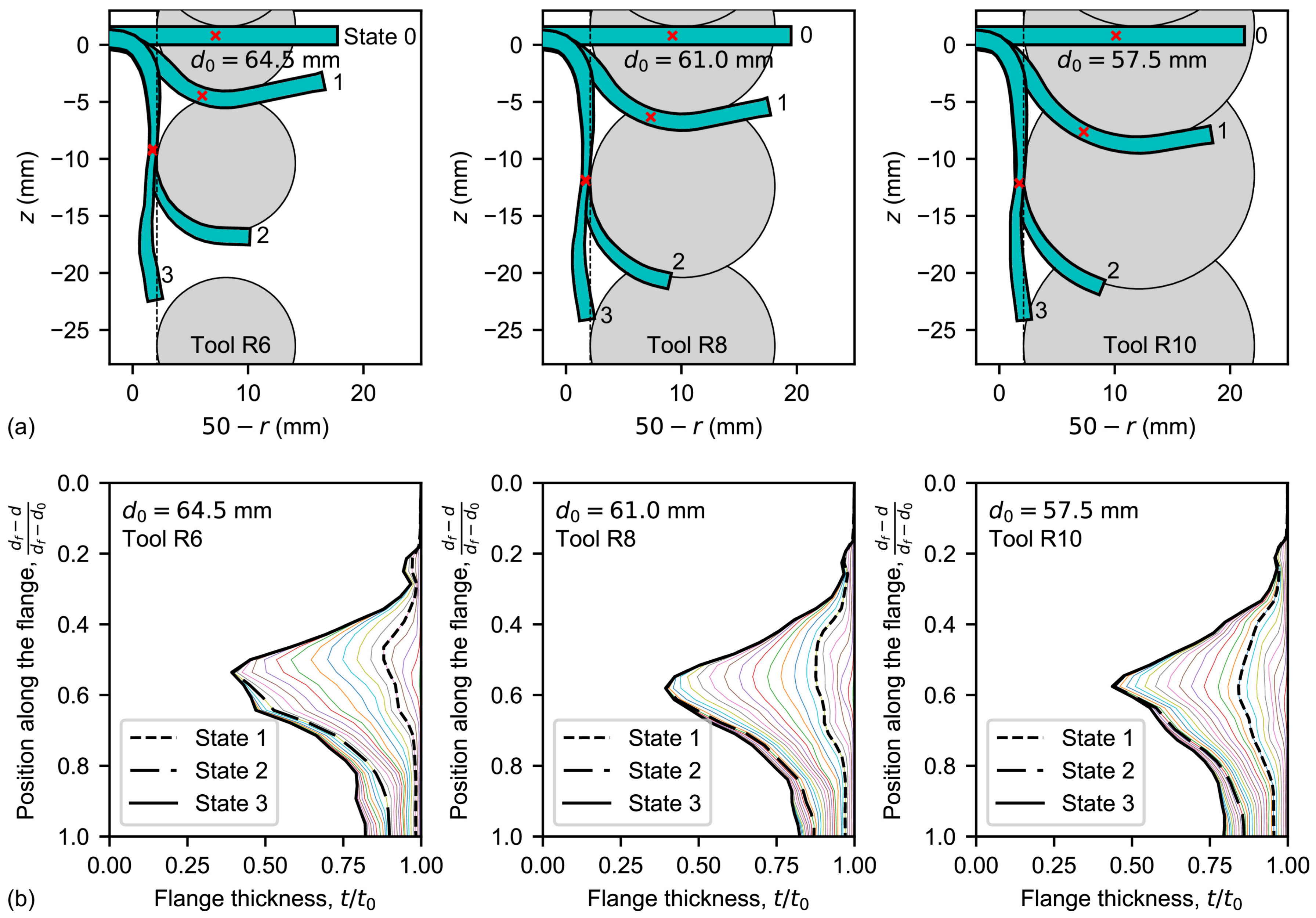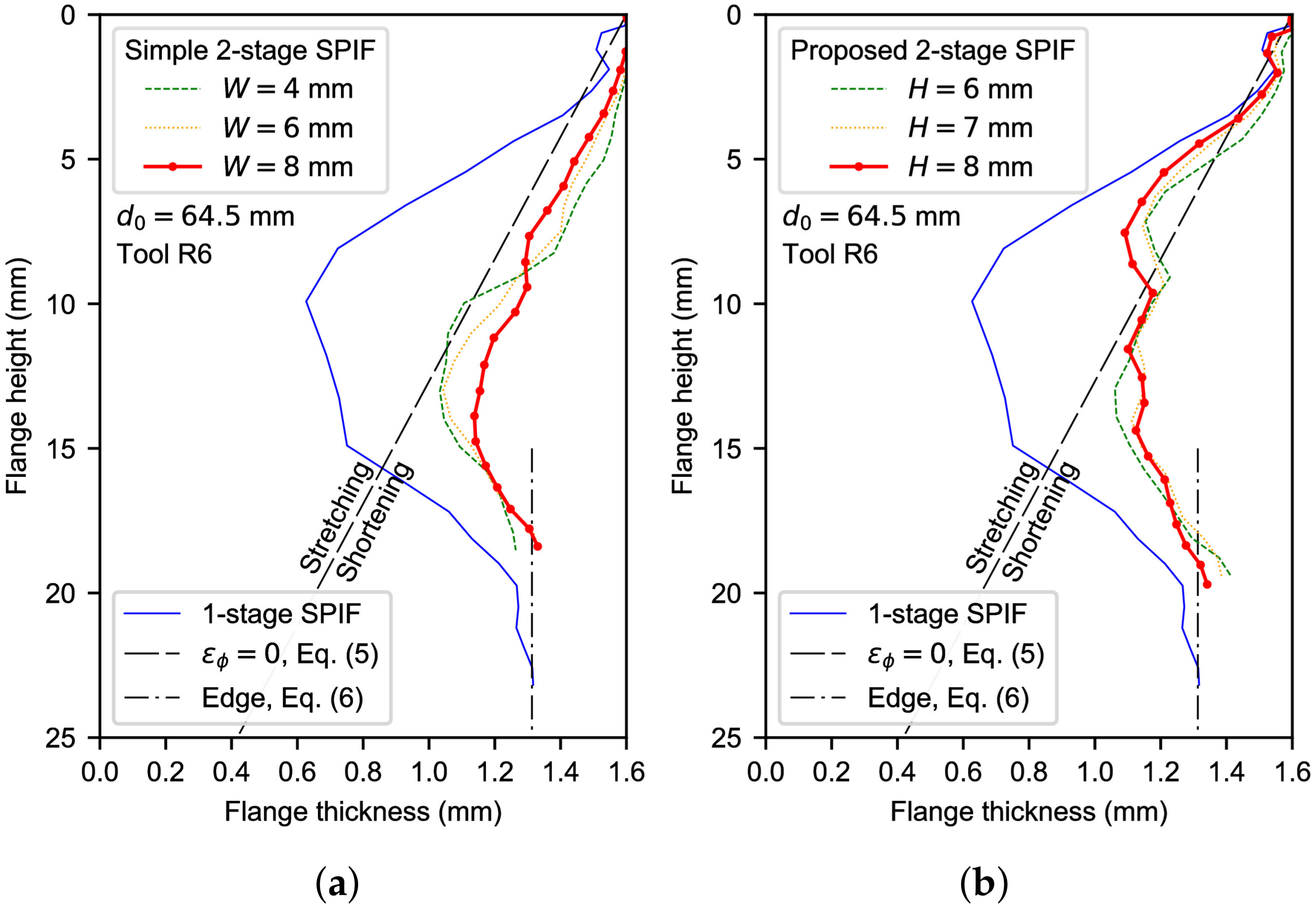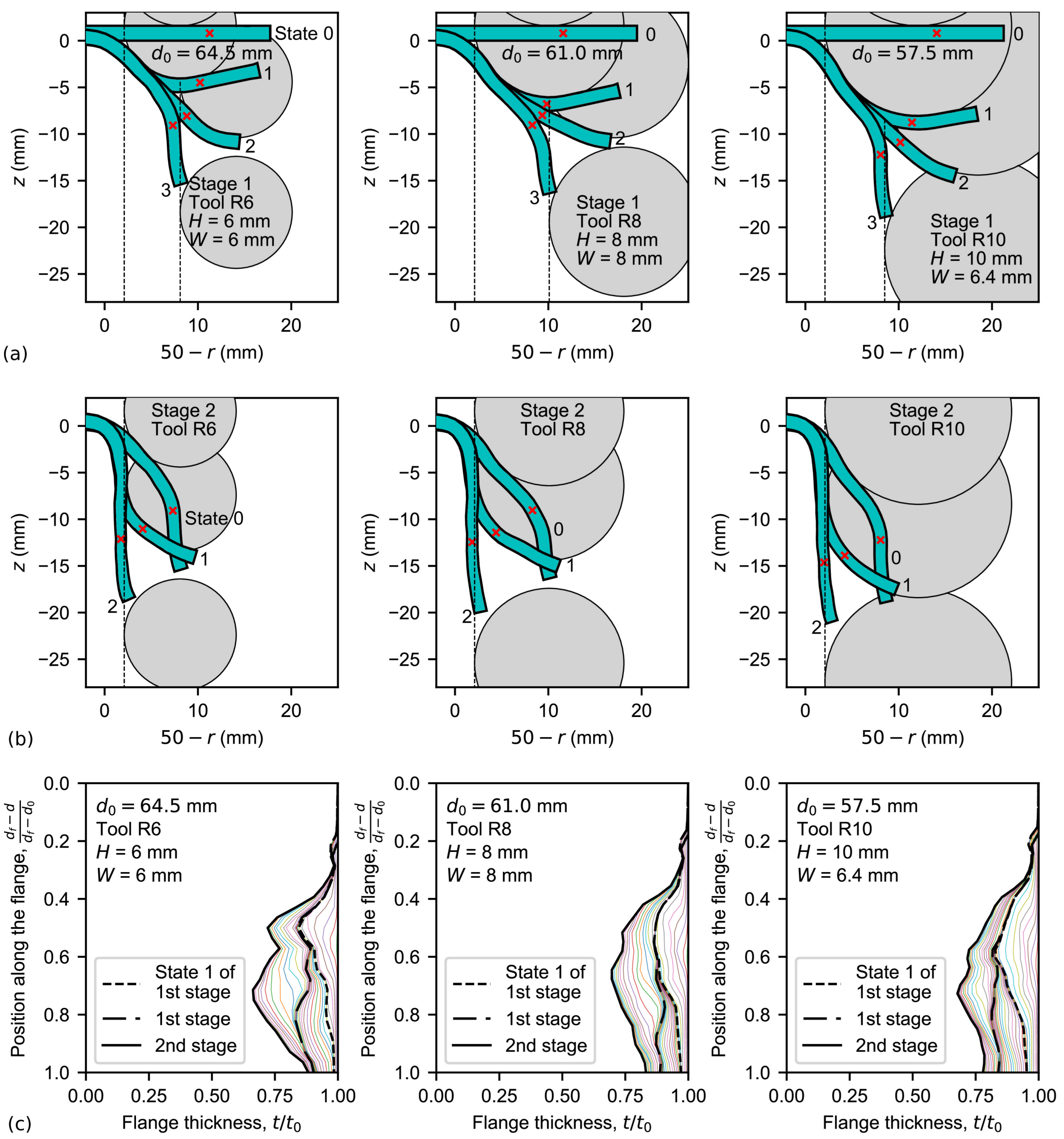The proposed methodology consists in analysing the process deformation and the flange thickness of the single-stage SPIF process with the aim of establishing a new SPIF strategy to homogenise the thickness profile along the flange.
2.1. Experimental Background: Hole-Flanging by SPIF in a Single Stage
In an above cited previous work [
11], the authors developed an experimental study consisting on the analysis of the physical mechanisms involved in the single-stage hole-flanging process by SPIF, aiming to evaluate the mechanical conditions upon which sheet failure takes place. With this purpose, the proposed single-stage strategy was utilized to perform a series of experimental tests on AA7075-O metal sheets of initial thickness
mm using different forming tools. As a result, the maximum flange that can be successfully achieved was manufactured and analysed.
The experimental tests were carried out on a 3-axis milling CNC machine VMC-200 (EMCO, Lingen, Germany). The experimental setup and a schema of the helical tool trajectory is shown in
Figure 1a. A blank holder and a backing plate with a 100-mm diameter circular hole were used to fix the sheet blanks to the machine table. Specimens were electro etched with a circle grid pattern at the outer sheet surface to analyse strains. Three different hemispherical tool radii were used (
, 8 and 10 mm) to analyse the bending effect (measured by the sheet thickness to tool radius ratio,
) on formability. The feed rate was set to 1000 mm/min and 2 spindle speed were used, 0 rpm (locked tool) and 1000 rpm clockwise. A step-down of 0.2 mm/rev was used for the helical trajectories. A special lubricant for metal forming applications, Iloform TDN81 (Castrol, Liverpool, UK) was used to minimise friction. The final flange height, thickness profile along the flanges and surface roughness were analysed on the final parts.
Sheet blanks with different pre-cut hole diameter
ranged from 55 to 82 mm were progressively deformed until producing hole flanges with a final inner diameter of
mm.
Figure 1b shows a sample of successful hole-flanged sheet. The limiting values of
to define the limit forming ratio (
) and obtain successful specimens were 64.5, 61.0 and 57.5 mm for tool radii of 6, 8 and 10 mm, respectively.
Some successful and failed specimens were cut for measuring the thickness in the profile view and, in case of fractured specimens, to validate the previous measurements along the crack.
Figure 1c shows the thickness profile of a successful hole-flanged sheet. As can be observed, there are 3 distinguishable zones along the flange, from top to bottom: (1) a zone near the flat undeformed sheet, whose thickness is progressively decreasing; (2) an intermediate or critical zone, where the thickness is the smallest and the sheet failure tends to occur; and (3) the edge zone, where thickness is progressively increasing.
2.2. Analysis of the SPIF Process Deformation
In previous work, the stress/strain states accomplished in sheet metal deformed by SPIF were evaluated by means of membrane analysis [
14,
15,
16]. The analytical model provides insight to the fundamentals behind the enhanced material formability of the SPIF process. The membrane analysis in axisymmetric components, illustrated in
Figure 2a, was used to explain aspects of the process deformation and formability. As a result, it was pointed out that the meridional stress component (
) is mainly responsible of sheet thinning and opening of cracks (mode I of fracture mechanics) at the transition zone between the inclined wall and the corner radius of the sheet, in contact with the forming tool. These conclusions seems to be also valid for hole-flanging operations, represented schematically in
Figure 2b. Indeed, the authors observed in failed specimens by single-stage SPIF that fracture initiates at the wall-tool interface limit [
11], as can be seen in
Figure 2c. Note that the onset of the crack coincided with the greatest thickness reduction or critical thickness.
The membrane analysis for SPIF of inclined-wall parts shows that the meridional stress
increases and sheet thickness
t decreases along the sheet-tool interface, from the formed wall to the still undeformed zone [
15]. This qualitative description of the thickness distribution agrees very well with experimental observations in hole-flanging by single-stage SPIF, as depicted in
Figure 2c. The membrane theory also predicts well the influence of the bending ratio
on the material formability of hole-flanging components [
11].
On the other hand, hole-flanging has some particularities with respect to the conventional testing geometries in SPIF (usually cones and pyramids) that were previously analysed by the membrane theory. The main difference of both deformation processes illustrated in
Figure 2a,b relies on the wall angle
, as well as in the circular hole of the sheet blank. In a SPIF process with a low or moderate
value, the plastic deformation is localised in the small zone in contact with the tool. Thus, the sheet thickness of the inclined-wall part can be estimated by the sine law,
, while the still flat material has not been plastically deformed yet and remains its initial thickness
. On the other hand, SPIF of components with severe
values up to 90° increase considerably the meridional stress distribution along the wall. In this situation, the plastic deformation extends beyond the area of contact with the forming tool, as the one that produces the hole expansion in hole-flanging (see schema in
Figure 2b).
The hole expansion leads a plastic deformation of material that is not in contact with the forming tool. The resistance of this material zone during its radial and circumferential stretching and its effect on the forming tool action is of great importance to understand the deformation process.
Figure 3 shows a forming tool acting on a sheet during hole-flanging by SPIF in a single stage. The following analysis is based on the one developed by Silva et al. [
15] for axisymmetric inclined-wall parts. The analysis focuses on a shell element located in the material being radially and circumferentially stretched due to the hole expansion and in the influence zone of the forming tool. Because of axial symmetry, principal stresses are assumed to be the circumferential (
), meridional (
), and thickness (
) stresses.
In
Figure 3, the tool is positioned along the sheet section A-B-C-D-E and the shell element is in the flat zone adjacent to the hole edge, between points B and C. The shell element is located at coordinates (
r,
) and has a thickness
due to the radial and circumferential expansion. The stresses acting on the shell element are also shown. Resolving the force equilibrium along the meridional direction one obtains
After neglecting higher order terms and simplifying the above equation by taking into account that
, Equation (
1) results in
The principal stresses acting on the shell element can be identified as
According to the Tresca yield criterion, the term
should be equal to the yield stress
. Inserting in Equation (
3) one obtains
. Substituting in Equation (
2) and integrating, the meridional stress in the shell element is found as
where the boundary condition
at the hole edge (
) was used to find the integration constant. Equation (
4) allows to evaluate the meridional stress
in the transition zone with the corner radius of the sheet in contact with the tool (
).
According to Silva et al. [
15], the reason why thinning occurs in the corner radius C-D has to do with
acting in that zone. Indeed, thinning in C-D tends to balance the increment of meridional stress so that
remains constant. According to this expression, thinning is especially relevant at point D. Besides, given that thickness at point C decreases as the SPIF process evolves and the hole expands, the sheet thickness in point D is getting more and more thin, in agreement with the experimental observations [
11].
Therefore, the sheet thinning at point D (critical thickness along the flange) could be diminished during the SPIF process by controlling the resistance of the material being radially and circumferentially stretched. According to Equation (
4), this could be achieved by reducing the yield stress or by increasing the hole edge radius
. This later solution can be achieved by performing a previous SPIF stage to modify the part geometry in the zone B-C.
2.3. Proposal for an Improved SPIF Strategy
Figure 4 presents 3 multi-stage SPIF strategies for hole-flanging proposed by Cui and Gao [
9] to analyse the thickness distribution along the sheet flange of AA6010 sheets. Strategies consist of producing one or more simple intermediate part shapes, and the final hole-flanged part, by programming linear sections. Experimental tests were performed using a number of stages ranged from 2 to 5. Different combinations of increasing values for wall angle and part diameter were used. In a later work, Bambach et al. [
10] used similar strategies to evaluate and exploit the flexibility of the SPIF technology to perform hole-flanging of mild steel sheets. Both experimental works concluded that flange thickness distribution obtained with the strategy illustrated in
Figure 4a was the most uniform among the forming strategies considered. However, this strategy produced actually a lower thinning in the initial part of the flange compared to the lower and more homogeneous thickness as approaching to the edge.
Consequently, the first strategy proposed to perform hole-flanging by SPIF in two stages consists in programming two concentric helical paths.
Figure 5a represents the tool path along the theoretical straight part section that defines the first stage. The distance
W defines the hole diameter of the intermediate sheet part. As exposed in
Section 4.3, this two-stage strategy produces a final thickness distribution of the flange according to the observations of the studies mentioned above [
9,
10]. Thus, an alternative strategy is needed to further reduce the thickness at the initial part of the flange.
Regarding the analysis of the single-stage SPIF process presented in the previous section, the sheet thickness distribution could be better homogenised by modifying the part geometry adjacent to the hole edge (zone B-C in
Figure 3). This can be done by performing a previous hole-flanging operation localised in that zone to increase the hole diameter, as illustrated in
Figure 5b–d. The main difference with the previous strategy is that the operations start as the single-stage SPIF process and the tool trajectories are later modified to reduce the pressure with the forming tool in the critical zone of the sheet.
The SPIF strategy shown in
Figure 5b was analysed in a recent numerical study [
12]. An automated procedure was performed to simulate the flange thickness using Abaqus/Explicit. A series of 18 sets of consistent values of
W,
A and
H were chosen to perform the study. It was concluded that the most homogeneous flange thickness was obtained using the highest angle value (
in the study) and a distance
W equals to the tool radius
R.
In the present work a SPIF strategy is proposed by taking into account the conclusions of the previous study. Thus, the angle and width parameters are fixed to
and
, as represented in
Figure 5c. It should be noted that the horizontal transition movement in the case of
requires an appropriate trajectory to avoid unexpected collisions due to the material springback. For instance, a spiral path could be used to smooth the sheet surface. Another option is to use a retract rapid movement upwards and inwards the hole and start the second drop from above. The optimum value of the height
H is assumed to be dependent on the material and process geometry.
The above strategy can be further improved by programming a faster circular transition movement instead of the horizontal one, as represented in
Figure 5d. Indeed, simulations performed with both options have shown almost identical thickness distributions. Therefore, in this work only the results obtained with strategies (a) and (d) shown in
Figure 5 are analysed and compared.






